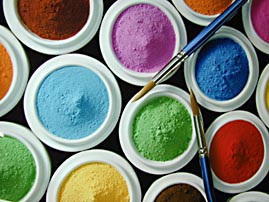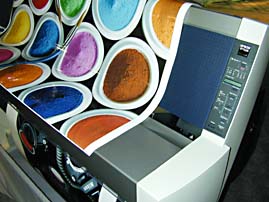Review of the quality of the Epson Stylus 9000.
Epson has produced a large format printer that produces impressive color of the highest professional quality. For the last two years we championed Encad large format printers because Encad wide format printers are production workhorses. We had Encad printers or prints on the home pages of four of our network of eight sites, and Encad printers or prints featured on the other four as well.
Then we had an opportunity to experience the Hewlett-Packard DesignJet 2800 and found that the HP printer was easier to use, required less maintenance, and produced a better quality image than the Encad. On top of that I get the impression that HP DesignJet printers cost less than Encad printers.
Now, after inspecting Epson printers and their output at Seybold '99 (San Francisco), at the Fuji booth of the Comdex '99 (Las Vegas) and at both the Fuji and Epson booths at PMA '00 we feel it is time to report how far Epson has come in reaching the professional market. The slow speed, fast fading colors, over saturation, costly ink, expensive paper, quirky print drivers and unrealistic claims in ads of the several low-end Epson desktop printers that we made the mistake of buying several years ago had left a lasting impression on us...but the Epson 9000 and newer Epson 7000 demonstrates conclusively that Epson can deliver a product acceptable to the professional market. Of course now the exciting new Epson 10000 is available, but the 9000 are still be sold at very attractive budget prices, so it's a tough decision.
With the Stylus 9000 Epson has produced a large format printer that is worthy of serious consideration by professionals. Now we are seriously considering replacing all the Encad printer images and reviews with Epson 9000 large format prints. Its hard to get a full appraisal of to what degree aftermarket inks cause clogged print heads. The sellers of aftermarket inks understandably report no or few clogged heads; Epson equally understandably says clogged heads do occur from aftermarket inks. We will report back when we have found a source of independent evaluation on these points.
If you want images that leap off the wall due to their dynamic color range, then consider the Epson 9000. I had previously been impressed by the ColorSpan and Roland, but after seeing the results of the Epson 9000 I am gradually changing my opinion.
 |
 |
So far we have only seen results at trade shows. Until we get an Epson 9000 in our own office and we continue to survey end users and gather assessments from the many trade shows. We have quite a network of information sources for all of this.
We are considering listing the Epson Stylus 9000 as ideal for photo studios, museums (for in-house wide format printing), for repro shops that want awesome color, and also for advanced hobby photographers who wish to exhibit their pictures in digital large format in situations where they don't mind if the prints fade in a few weeks in a sunny room or fade in a few months even in a room with no windows to the outside.
If you need an alternative, the 720 x 1440 quality of an Epson yet with ink longevity that won't clog the printheads, just ask the review editor. If you need to do fine art giclee prints or photo prints that need to have archival qualities, that is where we do most of our research (because FLAAR Photo Archive is the parent of the FLAAR Digital Imaging Technology Center. Photos are our middle name so we are always interested in finding the ultimate printer for photos.
In my opinion, at a distance the prints from the Epson look close to a Cibachrome print, which was the best print a darkroom could achieve in the past decades. Of course we also like the ColorSpan which is even closer to the quality of a Cibachrome and naturally the Lambda and LightJet are even better continuous-tone photo images, but Epson is getting there, and for a reasonable price. New inks and new paper (media) will allow you to produce Epson prints that last years and years (when the 7500 and 9500 are finished; at present they have a bit still to go before that stage).
In summary, Epson is entering a new market with this remarkable wide format printer. The Epson Stylus 9000 has somewhat overcome my aversion to low-end Epson inkjet printers of past years. The quality of this new printer has redeemed any earlier questions professionals might have had about whether this product was acceptable at the high-end. It may turn out that Epson's new 9500 will leapfrog the Roland and ColorSpan in fine art prints. The fact that Epson selected Electronics for Imaging is an indication that Epson has entered the big leagues of professional digital imaging. We recommend, however, the other RIPs, the software RIPs, as they are more flexible than any EFI product.
Thus we recommend you link your Epson up to a RIP from BEST, Onyx PosterShop, DCS Software PosterJet and other good software RIPs. If you need a high quality color management with your RIP, then BEST is the product to consider for your Epson RIP. If you need speed and ease of use in a production environment (tiling, nesting, etc) then you might consider PosterJet. If you have a dozen printers and full-time operators, you might wish Onyx PosterShop or its Ilford OEM version, RIPStar.
Is "closer" to the quality of a Cibachrome print good enough? ColorSpan is a rather impressive quality, albeit rather costly. So which printer should you buy, ColorSpan, Roland....or the Epson 9000? And what about the impressive alternative we saw at DRUPA, 3 years outside stability without even any lamination? What printer(s) won our attention as "best of show at DRUPA?" It is a printer and archival ink you have probably not yet considered.
We will be glad to assist you on your quest of what printer to select. Just e-mail the review editor Nicholas Hellmuth, Help is just a click away. Let us know what printers you are considering. If you are new to this we can do our best to provide introductory guidelines for selecting the proper wide format printer that will provide you the best solution. The tips and "what to watch out for" information are well worth the effort of clicking to send an e-mail.
For example, the quality may be nice, but if the inks fade within a few weeks you can hardly expect to sell these as fine art giclee prints. Yet there are now archival inks for longevity. Rather important to know about this before you buy the wrong printer. Yet some archival inks can't produce some red colors! Maybe you might want to know about this before you buy that printer.
Every printer does some tasks very well but perhaps not as good on other needs. So be realistic with precisely what kinds of work you need to print, about the speed and productivity that is necessary. Ignore the specs which are so eagerly published in ad claims. Find an actual end user to get a factual report on what it's really like in an office, studio, or home.
We recommend Parrot Digigraphic as a reliable place to buy the complete range of Epson printers, models 2000, 5500, both 7xxx models, both 9xxx models and either of the new 10000 models. Contact: John Lorusso, tel (978) 670-7766, fax (978) 670-7744, e-mail [email protected]. |
Also, did you know that certain printers can't print on all media? This is something the printer advertisements don't warn you about. Before you spend lots of money buying a large format printer, perhaps it might be helpful to get some professional advice. We strongly recommend, before you buy any brand, whether Encad, HP, Roland, or Epson, find other end-users and speak with them about their experiences.